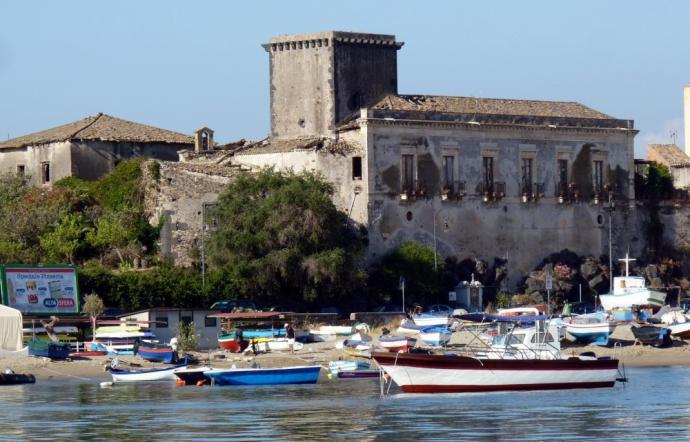
Castello di Schisò
Il nome “Schisò” deriva dal toponimo arabo di Naxos “Al Qusus”(seno o torace, riferimento alle formazioni vulcaniche che accolgono le fondamenta). Il castello, infatti, è stato edificato su una roccia creatasi a seguito di una colata lavica in epoca preistorica, e si affaccia sul lungomare di Giardini-Naxos. La sua costruzione risale ad epoca tardo medievale tra il XIII e il XIV secolo, come testimoniano le due torri cilindriche superstiti delle quattro che probabilmente definivano il complesso. All'interno è inglobata una chiesetta dedicata a S. Pantaleone, luogo di culto per contadini e pescatori, ed era parte del Monastero di Santa Maria di Gala dei monaci basiliani.
Fu ricostruito nel XVI secolo con una torre di avvistamento su Capo Schisò e sulla baia prospiciente. All'interno ha ospitato dal XVI secolo un impianto per la lavorazione della canna da zucchero. Nel XIX fu ulteriormente rinnovato con aggiunta di balconi sulla facciata che prospetta verso il mare.
Il Castello è stato inserito dalla Regione Siciliana nel Parco Archeologico Naxos Taormina ed è attualmente chiuso a pubblico per lavori di recupero.
(English)
Castle of Schisò
The name "Schisò" derives from the Arab place-name of Naxos "Al Qusus" (breast or thorax, reference to the volcanic formations that accommodate the foundations). The castle, in fact, was built on a rock created by a lava flow in prehistoric times, and overlooks the promenade of Giardini-Naxos. Its construction dates back to the late medieval period between the thirteenth and fourteenth centuries, as evidenced by the two surviving cylindrical towers of the four that probably defined the complex.
Inside is incorporated a small church dedicated to St. Pantaleone, a place of worship for farmers and fishermen, and was part of the Monastery of Santa Maria di Gala of Basilian monks.
It was rebuilt in the sixteenth century with a watchtower on Cape Schisò and the bay overlooking. Inside has hosted since the sixteenth century a plant for the processing of sugar cane. In the nineteenth century it was further renovated with the addition of balconies on the facade overlooking the sea.
The Castle has been included by the Sicilian Region in the Archaeological Park Naxos Taormina and is currently closed to the public for restoration work.